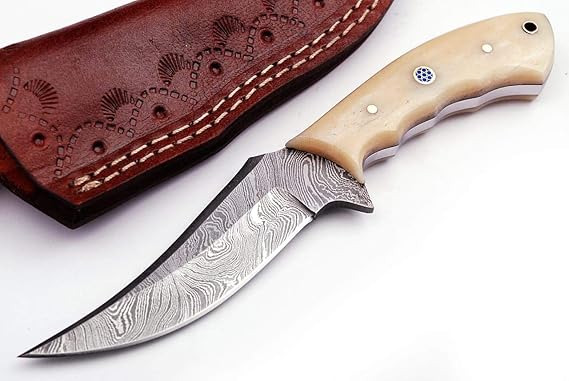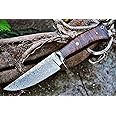Damascus steel hunting knives, with their breathtaking patterns and exceptional edge retention, are prized possessions for any serious hunter. But even the finest blade needs regular sharpening to maintain its peak performance. Sharpening Damascus steel, however, requires a slightly different approach than other steels due to its layered structure and often higher hardness. This guide will walk you through the best techniques, ensuring your Damascus hunting knife remains a razor-sharp tool for years to come.
Understanding Damascus Steel
Before diving into sharpening techniques, it’s crucial to understand the unique nature of Damascus steel. It’s not a single type of steel, but rather a composite material forged from multiple layers of different steels. This layering process creates the distinctive swirling patterns and contributes to the exceptional strength and edge retention. However, the varying hardness within the layers requires a more delicate approach to sharpening than a homogenous steel blade.
Aggressively sharpening Damascus steel can easily damage the delicate layers, leading to chipping or even ruining the blade’s aesthetic appeal. The goal is to hone the edge gently and consistently, maintaining the integrity of the layers while achieving a razor-sharp result.
Sharpening Methods: A Comparative Look
Several methods can successfully sharpen Damascus steel hunting knives. The best choice depends on your skill level, available tools, and desired level of precision. Let’s explore the most popular options:
1. Sharpening Stones: The Traditional Approach
Sharpening stones, or whetstones, offer excellent control and precision, making them a favorite among experienced knife sharpeners. You’ll need a progression of stones, starting with a coarser grit (e.g., 200-400 grit) to remove significant damage and ending with a finer grit (e.g., 8000-12000 grit) for a razor-sharp, polished edge. Always maintain a consistent angle (typically between 15-20 degrees) throughout the process.
Pros: Precise control, excellent edge, relatively inexpensive (compared to electric sharpeners).
Cons: Requires practice and patience, time-consuming.
2. Electric Sharpeners: Speed and Convenience
Electric sharpeners provide a faster and more convenient sharpening experience, especially for those new to knife sharpening. However, not all electric sharpeners are created equal. Choose a model specifically designed for high-carbon steel or Damascus steel, paying attention to adjustable angle settings. Avoid overly aggressive electric sharpeners, as they can easily damage delicate Damascus layers.
Pros: Fast and easy, less demanding on technique.
Cons: Can be expensive, may not offer the same level of control as sharpening stones, potential for damage if not used carefully.
3. Guided Sharpening Systems: A Balanced Approach

Guided sharpening systems offer a compromise between the precision of sharpening stones and the convenience of electric sharpeners. These systems use a fixture to maintain a consistent angle, making it easier to achieve a sharp edge even for beginners. They are often paired with sharpening rods or stones.
Pros: Easier to use than freehand sharpening, good control, relatively affordable.
Cons: Not as versatile as sharpening stones, can still require some practice.
Honing vs. Sharpening: A Crucial Distinction

Many people confuse honing with sharpening. Honing refers to straightening the edge of an already sharp knife, not actually removing material. A honing steel or strop is excellent for maintaining the sharpness of your Damascus blade between sharpening sessions. It realigns the microscopic teeth of the blade, restoring its cutting ability without altering the blade’s geometry.
Maintaining Your Damascus Hunting Knife

Proper care extends the life and sharpness of your Damascus steel knife. Always clean and dry your knife thoroughly after each use. Avoid leaving it in damp conditions or soaking it in water. Regular oiling with a high-quality knife oil will protect the blade from rust and corrosion.
Choosing the Right Sharpening Tools

The success of sharpening your Damascus steel hunting knife hinges on choosing the right tools. High-quality sharpening stones are a worthy investment for serious knife enthusiasts, but a reliable electric sharpener can also be a convenient choice. Regardless of your chosen method, always prioritize a slow and steady approach, particularly when dealing with the complex layered structure of Damascus steel.
Sharpening your Damascus steel hunting knife may seem daunting, but with the right tools, techniques, and a bit of patience, you can maintain a razor-sharp edge for years to come. Remember to prioritize safety and take your time, and your beautiful Damascus steel hunting knife will reward you with exceptional cutting performance in the field.